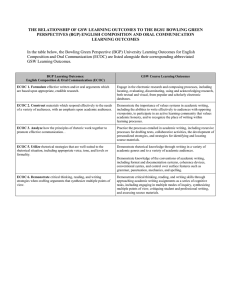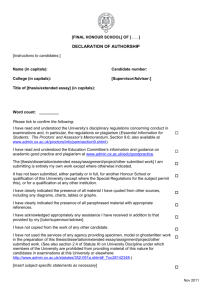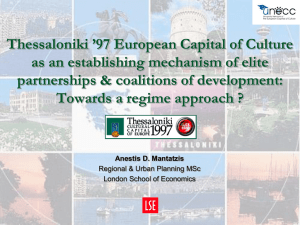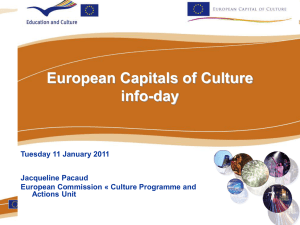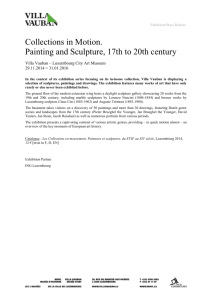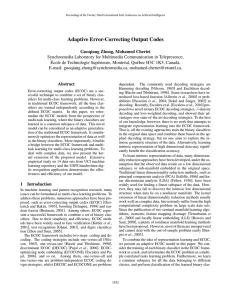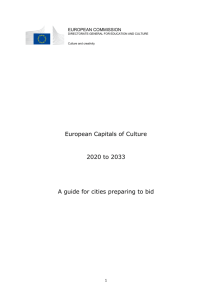toolkit of best practices and recommendations
advertisement
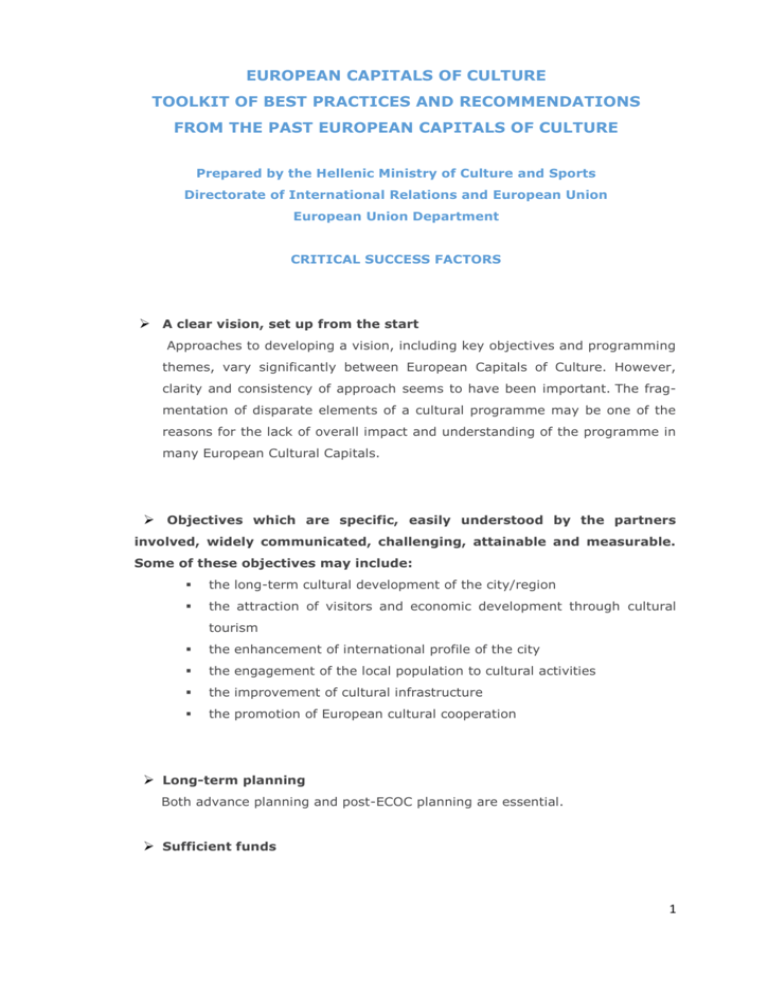
EUROPEAN CAPITALS OF CULTURE TOOLKIT OF BEST PRACTICES AND RECOMMENDATIONS FROM THE PAST EUROPEAN CAPITALS OF CULTURE Prepared by the Hellenic Ministry of Culture and Sports Directorate of International Relations and European Union European Union Department CRITICAL SUCCESS FACTORS A clear vision, set up from the start Approaches to developing a vision, including key objectives and programming themes, vary significantly between European Capitals of Culture. However, clarity and consistency of approach seems to have been important. The fragmentation of disparate elements of a cultural programme may be one of the reasons for the lack of overall impact and understanding of the programme in many European Cultural Capitals. Objectives which are specific, easily understood by the partners involved, widely communicated, challenging, attainable and measurable. Some of these objectives may include: the long-term cultural development of the city/region the attraction of visitors and economic development through cultural tourism the enhancement of international profile of the city the engagement of the local population to cultural activities the improvement of cultural infrastructure the promotion of European cultural cooperation Long-term planning Both advance planning and post-ECOC planning are essential. Sufficient funds 1 a confirmed budget should be in place as early as possible in the preparation phase. A balance between event programming and relevant infrastructure development This is an area where marked differences exist, but a common issue is the city’s ability to determine whether investment in infrastructures (either cultural or for supporting services) is required in order to maximise the benefits of the ECoC year, and whether this needs to be coordinated directly by ECoC teams or developed in parallel. The approach to infrastructure for each ECOC depends entirely on the ECOC aims and objectives. There is no imperative to consider infrastructure development as an essential element of an ECOC programme. Particular attention needs to be paid to several critical issues. Amongst these are the following: Clear assessments of needs and feasibility Realistic time scales Adequate resources Sustainability Broad public engagement Dedicated strategies to involve the local population and maximise their sense of ownership, from targeted community programming to volunteering schemes. Partnerships The development of partnerships with many different stakeholders is of primary importance: cultural institutions, local independent arts groups, business and tourism sectors and social services/community organisations. Political support and artistic freedom On the one hand, political commitment is fundamental as most of the funds for the event are public. On the other hand, artistic and cultural independence are also crucial for a successful implementation of the cultural and artistic program. Governance of the ECOC 2 It is important: to develop a small structure with a clear role and common direction to ensure strong leadership at the Board, define precise roles to clarify in considerable detail the division of responsibilities between the Board and the professional staff of the ECOC organisation to have competent and experienced personnel at all levels A successful cultural programme should ensure a balance between: Traditional and contemporary culture High-profile events and local initiatives City centre and suburb/regional locations “High” art and popular art/culture Established cultural institutions and independent groups and artists International names and local talents Usual activities and new activities Professional and amateur/community projects Quality of the projects selected. It is important to take into account the quality of the projects the cost the relevance to the programme’s aims the experience of the organisers the long-term impact or sustainability of the programmes. the city’s assets and history the cultural identity of the area as well as the European dimension European dimension of the projects: The most common suggestions are the following: Prioritise this dimension if it is to be significant Ensure that a fair proportion of the budget is linked to this priority Define the goals and coherent themes, and develop a clear strategy. Do not collect individual projects and ideas here and there Select European partners carefully. Build on existing links and connections Start early to make contacts and plan far in advance Ensure there is real expertise available to help. Experts can be local, but many work internationally. Invite them to participate 3 Focus on the quality and profile of projects More challenging European projects are likely to have the greatest impact Do not be afraid to deal with difficult or controversial themes Ensure a public dimension to European projects. Do not only focus on artist-to-artist exchanges The main pieces of advice given by previous ECOC stakeholders regarding the cultural programme are as follows: Select fewer projects Clearly define the aims, objectives and themes and adhere to these Ensure good and adequate communication of the programme Find the balance between popular events and smaller initiatives Develop a programme suitable for the city. Each city is at a different phase of its historical, cultural, social and economic development, and this context must be taken into consideration. Think about what will happen the year after the event Do not be afraid of making choices 4 BEST PRACTICES Different cities define culture differently, although many opt for a wider meaning than the production of art and include sport, gastronomy, and much else besides. In Graz, the Kitchen cooking project involved the making of ethnic meals cooked by local citizens in a central park of the city Helsinki had a sauna of the month project Rotterdam “Preaching in Another Man’s Parish” involved ministers of different faiths preaching in each other’s places of worship. Most cities have used the capital year as an occasion to restore, transform or build new cultural and other buildings. Weimar 1999 renovated its train station Copenhagen 1996 developed its former naval yards to house academies Thessaloniki 1997 and Porto 2001 undertook major urban remodeling Luxembourg 1995 had the world-renowned IM Pei design their new museum of modern art and French architect Christian de Portzamparc a magnificent new Philharmonic concert hall. But it isn’t just a question of infrastructure: often the image of the city changes for the better, thus encouraging investment and tourism, and fostering employment and growth. In some cases, the city’s cultural players discovered new ways of working together, and some new and enduring collaborations were also born at a European level. A major contributor to a cultural year’s success is media coverage and, increasingly, the creative use of the internet. Since 1995, all European Capitals of Culture have had websites and many have used the internet for debates, broadcasting and e-conferences. Another major plus is the effectiveness of partnerships with local sponsors. For Lille 2004 the national railway SNCF offered cut-price tickets to Lille from cities in France and Belgium. 5 The European dimension has been expressed in a number of ways. Presenting events (productions, performances, exhibitions) that focus on the talents of European artists (for example, Literature Express and The House of the Nine Cities in Brussels bringing writers or artists to public events at the European Parliament, the concert by U2 in Thessaloniki, European Jazz Festival in Graz, Futurice fashion event in Reykjavik, European lecture series in Helsinki) Collaborations, co-productions, exchanges and other means of developing cooperation between artists, cultural organisations and groups who are based in different European countries (for example Nordic and Baltic projects in Copenhagen and Helsinki, opera and theatre performances in Salamanca) Developing European themes and issues (multiculturalism and multilingualism in Luxembourg, communication in Bologna, interfaith and religions in Graz, migration and exile in Copenhagen) Identifying and celebrating aspects of European history, identity and heritage that are present already in the designated city (for example The role of Genoa in Europe during the XVII century; the importance of Santiago to European travellers; Luxembourg as the birthplace of Robert Schuman; numerous ideologies and cultural figures associated with Weimar; exhibition of Bruges as a European Crossroad; Erasmus in Rotterdam; exhibition of Alexander the Great in Thessaloniki) Very specific partnerships between two or more cities (for example Café Nine.net and the Voices of Europe project with the nine ECOC in 2000, the squatters project between Porto and Rotterdam, the symbolic naming or declarations made between Salamanca and Bruges or Graz and St Petersburg) or within a region (for example Lille’s partnership with towns across national borders of France and Belgium). Promoting European tourism (a specific objective for Bergen, Avignon and Genoa) Citizen participation is another criterion the European Union has decreed a central requisite of any European Capital of Culture, starting with street parades and moving on to anything that makes people feel involved. 6 Patras 2006 put forward a major programme for volunteers who became ambassadors for the event Liverpool 2008’s volunteer programme gave the people of the working-class district of Meyerside the chance to train as city hosts Lille 2004 locals were involved from the start and the participation from schools was very active The use of public space was the most common means to increase participation in and accessibility to culture. Programmes have also included a large number of “free” events. in Salamanca, of the 1100 activities in the programme 800 of these (73%) offered free entrance in Thessaloniki over 70% of projects were free and free food was also supplied at most events in Helsinki the approximately one-third of events that were free attracted an estimated 3,3 million visitors. Projects that were highlighted as being the most successful in terms of public and media attention were key exhibitions, concerts by international artists and special one-off events. Examples of these are: “La Beauté” exhibition in Avignon (attendance : 200.000) The Van Eyck exhibition in Bruges (attendance : 322.000) The Rubens exhibitions in Lille (attendance : 300.000) and Genoa The Hieronymus Bosch exhibition in Rotterdam (attendence : 200.000) The Treasures of Mount Athos exhibition in Thessaloniki (attendance : 700.000) The Rolling Stones concert in Luxembourg (attendance : 60.000) The Oasis and Van Morrison concerts in Salamanca The Cutty Sark Tall Ships Race in Copenhagen and Helsinki The Meeting of celebrity poets in Cracow 7 SOME RECOMMENDATIONS BY THE MANAGING AUTHORITIES OF THE PAST EUROPEAN CAPITALS OF CULTURE “Start organising events and activities in plenty of time and put together a programme that takes into account the city’ s characteristics and peculiarities. The programme should include mainstream cultural events as well as more innovative ones. These cultural events should have a long-term impact on the city’s cultural, economic and social development, while at the same time encouraging citizen participation.” (former Florence’s Councillor for Cultural Affairs Mr. Giorgio Morales at the time of Florence’s Year as European Culture Capital 1986 and Mrs. Ada Tardelli, Giorgio Morales’ former Secretary and member of the Organising Secretary Office for Florence’s Year as European Culture Capital 1986.) “I believe you must start with a vision and a profound belief in the value of the process of becoming a European Capital of Culture. The cultural dimension must be the unifying concept and it mustn’t be overshadowed by issues connected to political ambition. A longer-term perspective is essential. A European Capital of Culture can never and never has been a quick fix to repairing a broken political mechanism, or a tarnished city image, or a city that is divided culturally or ethnically, or that has a failing economy. A European Capital of Culture can be one part of a process that may lead to solutions to some of these problems, but it cannot in itself be the solution. Another point is to ensure ownership of the event by local residents. The ideas behind the European Capitals of Culture have to inspire the people of the city, as well as its leaders and decision-makers. In very practical terms, the programme should emphasize quality over quantity; the budget needs to be agreed and fixed at a reasonable level in advance. These are only a few ingredients I have discovered. There are many more. Preparing a European Capital of Culture is a monster and epic task, filled with headaches and delights, and for future cities, I can only say “it is not at all easy, so think twice before you say ‘yes’!” (Robert Palmer, Director, Glasgow 1990 European Capital of Culture) “The most important thing is to have a clear policy. There is no blueprint for a European Capital of Culture but you have to know what you want to do, whether you want it to be a marketing or a touristic project, or whether you want it to be about art. Try to create structures that are independent of the 8 political scene so that you can work with total independence. And don’t overspend. If you have a little less money, you have to make choices and when you make choices you know where your priorities lie.” (Eric Antonis, Director of Antwerp ’93) “I would say that they should take advantage of this unique opportunity to invest in their city’s cultural sustainability, in the creation of new dynamics and new cultural habits, in the creation of new audiences, in the development of the city’s heritage, in helping young creators, in the involvement and participation of citizens in the event itself and in their cultural future, in the promotion of European networks for culture, in the mobility of artists, in the internal and international promotion of a cultural agenda that makes people want to visit the city.” (Simonetta Luz Afonso, member of the Board of Lisboa 94 in charge of exhibitions) “The first thing I’d say is that you need to be aware that it’ s the city itself that chose to be a cultural capital, and so you want to collaborate well with the city board. Secondly, the European Capital of Culture project shouldn’t see itself as a cultural initiative that stands apart, but it must enter the existing situation and work with it. Thirdly, you have to structure the programme throughout the year. I’ve been to many European Capitals of Culture for a couple of days and found that nothing is happening. You have to remember that people are visiting the place because it’s a European Capital of Culture so you have to make sure there’s something happening every day.” (Hugo De Greef, General manager, Bruges 2002) “Remain true to yourself and at the same time keep several objectives in mind. Culture must be at the heart of the agenda but you also need to think of things in the long term, and you have to make sure that the people who live in the city feel involved. You need to work at all levels, and help people to participate actively in neighbourhood celebrations and soon. The city has to be in movement with the sort of energy that visitors from outside can perceive.” (Laurent Dreano, General Manager, Lille 2004) “Have a clear set of objectives that you aim to achieve through the designation and communicate these clearly and regularly. Engage the decision 9 makers and the media. It is not just about the arts and culture sector to be successful the city needs to have an overall vision and have a clear sense for where culture fits within that. Ensure good leadership at a civic and project level. Be realistic about expectations and manage expectations, communicate regularly and often. As a project team member keep some objectivity.” (Mary Mc Carthy, Director of the National Sculpture Factory Cork 2005) “The most important thing is to have an interesting motto, aimed both at the local people and at the European public. Most European culture capitals have quite similar programmes, with performances by international names like Bob Wilson and Akram Khan. The challenge is to have something European that also has a local flavour. That’s quite difficult. Communication is another big challenge. You don’t want to communicate only about the avant-garde art that interests 3 percent of people, but you don’t want to alienate the art-oriented people with an overly mainstream programme. You have to constantly maintain two levels of communication, one aimed at an audience keen on culture, the other more mainstream. We made a mess of that by being a little too highbrow. When I visit cities preparing their candidature, I stress the importance of a solid budget, a good communication strategy and an original programme.” (Robert Garcia, Coordinator general, Luxembourg 2007) 10 BIBLIOGRAPHY This document summarizes the publications of the European Commission as follows: 1. European Capitals of Culture: the road to success, from 1985 to 2010 European Commission Luxembourg: Office for Official Publications of the European Communities 2009 2. European Cities and Capitals of Culture Study Prepared for the European Commission PART I PALMER/RAE ASSOCIATES, BRUSSELS August 2004 3. European Cities and Capitals of Culture Study Prepared for the European Commission PART II PALMER/RAE ASSOCIATES, BRUSSELS August 2004 4. DIRECTORATE GENERAL FOR INTERNAL POLICIES POLICY DEPARTMENT B: STRUCTURAL AND COHESION POLICIES CULTURE AND EDUCATION EUROPEAN CAPITALS OF CULTURE: SUCCESS STRATEGIES AND LONG-TERM EFFECTS STUDY November 2013 European Union, 2013 AUTHORS Beatriz Garcia, Tamsin Cox 11
